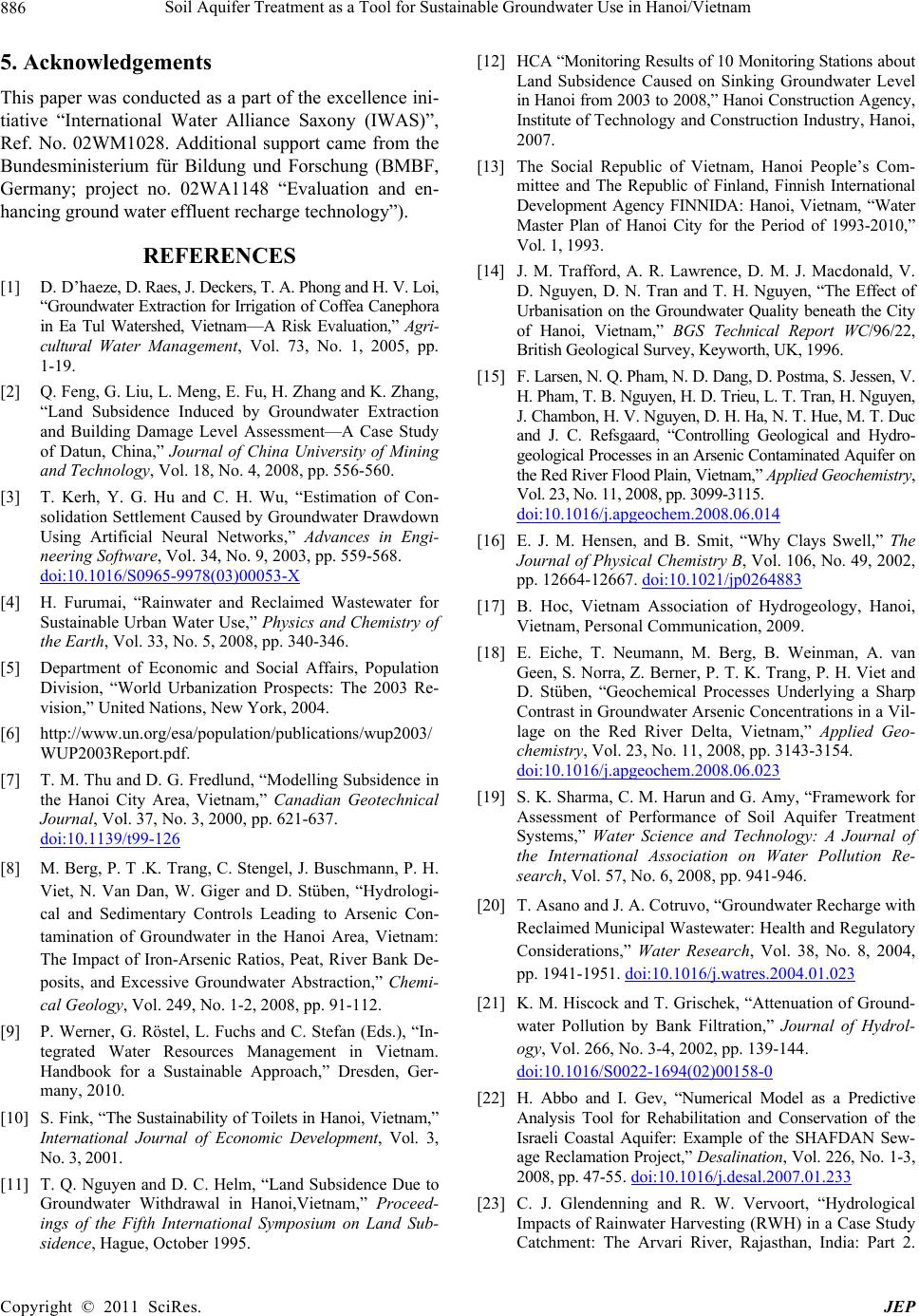
Soil Aquifer Treatment as a Tool for Sustainable Groundwater Use in Hanoi/Vietnam
886
5. Acknowledgements
This paper was conducted as a part of the excellence ini-
tiative “International Water Alliance Saxony (IWAS)”,
Ref. No. 02WM1028. Additional support came from the
Bundesministerium für Bildung und Forschung (BMBF,
Germany; project no. 02WA1148 “Evaluation and en-
hancing ground water effluent recharge technology”).
REFERENCES
[1] D. D’haeze, D. Raes, J. Deckers, T. A. Phong and H. V. Loi,
“Groundwater Extraction for Irrigation of Coffea Canephora
in Ea Tul Watershed, Vietnam—A Risk Evaluation,” Agri-
cultural Water Management, Vol. 73, No. 1, 2005, pp.
1-19.
[2] Q. Feng, G. Liu, L. Meng, E. Fu, H. Zhang and K. Zhang,
“Land Subsidence Induced by Groundwater Extraction
and Building Damage Level Assessment—A Case Study
of Datun, China,” Journal of China University of Mining
and Technology, Vol. 18, No. 4, 2008, pp. 556-560.
[3] T. Kerh, Y. G. Hu and C. H. Wu, “Estimation of Con-
solidation Settlement Caused by Groundwater Drawdown
Using Artificial Neural Networks,” Advances in Engi-
neering Software, Vol. 34, No. 9, 2003, pp. 559-568.
doi:10.1016/S0965-9978(03)00053-X
[4] H. Furumai, “Rainwater and Reclaimed Wastewater for
Sustainable Urban Water Use,” Physics and Chemistry of
the Earth, Vol. 33, No. 5, 2008, pp. 340-346.
[5] Department of Economic and Social Affairs, Population
Division, “World Urbanization Prospects: The 2003 Re-
vision,” United Nations, New York, 2004.
[6] http://www.un.org/esa/population/publications/wup2003/
WUP2003Report.pdf.
[7] T. M. Thu and D. G. Fredlund, “Modelling Subsidence in
the Hanoi City Area, Vietnam,” Canadian Geotechnical
Journal, Vol. 37, No. 3, 2000, pp. 621-637.
doi:10.1139/t99-126
[8] M. Berg, P. T .K. Trang, C. Stengel, J. Buschmann, P. H.
Viet, N. Van Dan, W. Giger and D. Stüben, “Hydrologi-
cal and Sedimentary Controls Leading to Arsenic Con-
tamination of Groundwater in the Hanoi Area, Vietnam:
The Impact of Iron-Arsenic Ratios, Peat, River Bank De-
posits, and Excessive Groundwater Abstraction,” Chemi-
cal Geology, Vol. 249, No. 1-2, 2008, pp. 91-112.
[9] P. Werner, G. Röstel, L. Fuchs and C. Stefan (Eds.), “In-
tegrated Water Resources Management in Vietnam.
Handbook for a Sustainable Approach,” Dresden, Ger-
many, 2010.
[10] S. Fink, “The Sustainability of Toilets in Hanoi, Vietnam,”
International Journal of Economic Development, Vol. 3,
No. 3, 2001.
[11] T. Q. Nguyen and D. C. Helm, “Land Subsidence Due to
Groundwater Withdrawal in Hanoi,Vietnam,” Proceed-
ings of the Fifth International Symposium on Land Sub-
sidence, Hague, October 1995.
[12] HCA “Monitoring Results of 10 Monitoring Stations about
Land Subsidence Caused on Sinking Groundwater Level
in Hanoi from 2003 to 2008,” Hanoi Construction Agency,
Institute of Technology and Construction Industry, Hanoi,
2007.
[13] The Social Republic of Vietnam, Hanoi People’s Com-
mittee and The Republic of Finland, Finnish International
Development Agency FINNIDA: Hanoi, Vietnam, “Water
Master Plan of Hanoi City for the Period of 1993-2010,”
Vol. 1, 1993.
[14] J. M. Trafford, A. R. Lawrence, D. M. J. Macdonald, V.
D. Nguyen, D. N. Tran and T. H. Nguyen, “The Effect of
Urbanisation on the Groundwater Quality beneath the City
of Hanoi, Vietnam,” BGS Technical Report WC/96/22,
British Geological Survey, Keyworth, UK, 1996.
[15] F. Larsen, N. Q. Pham, N. D. Dang, D. Postma, S. Jessen, V.
H. Pham, T. B. Nguyen, H. D. Trieu, L. T. Tran, H. Nguyen,
J. Chambon, H. V. Nguyen, D. H. Ha, N. T. Hue, M. T. Duc
and J. C. Refsgaard, “Controlling Geological and Hydro-
geological Processes in an Arsenic Contaminated Aquifer on
the Red River Flood Plain, Vietnam,” Applied Geochemistry,
Vol. 23, No. 11, 2008, pp. 3099-3115.
doi:10.1016/j.apgeochem.2008.06.014
[16] E. J. M. Hensen, and B. Smit, “Why Clays Swell,” The
Journal of Physical Chemistry B, Vol. 106, No. 49, 2002,
pp. 12664-12667. doi:10.1021/jp0264883
[17] B. Hoc, Vietnam Association of Hydrogeology, Hanoi,
Vietnam, Personal Communication, 2009.
[18] E. Eiche, T. Neumann, M. Berg, B. Weinman, A. van
Geen, S. Norra, Z. Berner, P. T. K. Trang, P. H. Viet and
D. Stüben, “Geochemical Processes Underlying a Sharp
Contrast in Groundwater Arsenic Concentrations in a Vil-
lage on the Red River Delta, Vietnam,” Applied Geo-
chemistry, Vol. 23, No. 11, 2008, pp. 3143-3154.
doi:10.1016/j.apgeochem.2008.06.023
[19] S. K. Sharma, C. M. Harun and G. Amy, “Framework for
Assessment of Performance of Soil Aquifer Treatment
Systems,” Water Science and Technology: A Journal of
the International Association on Water Pollution Re-
search, Vol. 57, No. 6, 2008, pp. 941-946.
[20] T. Asano and J. A. Cotruvo, “Groundwater Recharge with
Reclaimed Municipal Wastewater: Health and Regulatory
Considerations,” Water Research, Vol. 38, No. 8, 2004,
pp. 1941-1951. doi:10.1016/j.watres.2004.01.023
[21] K. M. Hiscock and T. Grischek, “Attenuation of Ground-
water Pollution by Bank Filtration,” Journal of Hydrol-
ogy, Vol. 266, No. 3-4, 2002, pp. 139-144.
doi:10.1016/S0022-1694(02)00158-0
[22] H. Abbo and I. Gev, “Numerical Model as a Predictive
Analysis Tool for Rehabilitation and Conservation of the
Israeli Coastal Aquifer: Example of the SHAFDAN Sew-
age Reclamation Project,” Desalination, Vol. 226, No. 1-3,
2008, pp. 47-55. doi:10.1016/j.desal.2007.01.233
[23] C. J. Glendenning and R. W. Vervoort, “Hydrological
Impacts of Rainwater Harvesting (RWH) in a Case Study
Catchment: The Arvari River, Rajasthan, India: Part 2.
Copyright © 2011 SciRes. JEP